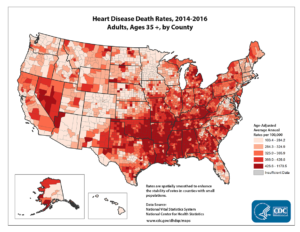How to save 400,000 lives per year (four million in the world)
 When I wrote recently that my predictions for 2020 would include some things I hoped would happen, this was the column I had in mind. What follows is a prediction that will definitely not happen unless someone decides to make a change.
When I wrote recently that my predictions for 2020 would include some things I hoped would happen, this was the column I had in mind. What follows is a prediction that will definitely not happen unless someone decides to make a change.
But not everybody has to die young or in middle age from many of the diseases that afflict our society. In the United States, our single leading cause of death is heart disease with 650,000 deaths per year. Heart attacks cause more than 400,000 deaths alone. With approximately 800,000 heart attacks per year in the U.S., 50 percent of heart attacks lead directly to death.
Nobody has to die of a heart attack. But 400,000 Americans (four million people on the planet) die of heart attacks every year. This is mostly because of a glaring flaw in the business of medicine - a flaw that could be easily fixed.
The CDC estimates the economic impact of heart attacks each year is $220 billion in medical care and lost productivity. Who wouldn't want to save $220 billion per year?
My father died of a heart attack on my birthday in 1991, so this is personal.
I am not a doctor, but I am also not a fool, so take this information, do your own research, and decide for yourself what to do.
When you have a heart attack, the simple story is that your heart can't get enough oxygen so your heart muscle goes into spasms and begins to die. If the heart attack is mild or caught soon enough you will survive. Most heart attacks don't lead to instant death. Heck, 20 percent of first heart attacks aren't even detected. But pretty much all heart attacks include permanent damage to the heart muscle. This damage makes another heart attack more likely. Two hundred thousand heart attacks per year in the U.S. aren't the patient's first. And a damaged heart makes disability and death both more likely.
Your chances of ever being able to work again are directly related to whether your heart muscle is permanently damaged.
Here is where this story gets interesting.Chloramphenicol is an antibiotic used mainly to treat eye infections, though it was originally developed 70 years ago to treat bubonic plague. Chloramphenicol is an ancient medicine, its patent long ago expired. Any generic drug company can make it in any country. Overseas it costs under $2 per dose ($40+ in America - why is that?).
When administered in a large intravenous dose within a couple hours of a heart attack, Chloramphenicol seems to prevent the heart muscle from being damaged. The mechanism by which Chloramphenicol works still isn't well understood, but it seems to bump the heart into autophagy, which is a condition where the heart muscle cells eat their own cellular garbage for energy, thus avoiding damage. Autophagy is the direct physical benefit of fasting, in this case, imposed on the heart, thus saving it.
Every hospital, every emergency room, every EMT and ambulance should have a big dose of Chloramphenicol ready for those 800,000 heart attack victims per year. Doing so would not only save 400,000 lives per year, it would send 400,000 people back to whatever it was they were doing before their heart attack.
Emergency treatment is not a substitute for treating coronary artery disease, but it would save lives and allow second chances.
Published a decade ago, these facts have saved no lives. Four million Americans have died who didn't have to die.
Four million Americans died because Chloramphenicol is off-patent so no drug company will touch it.
Chloramphenicol is an approved drug, but not approved for this purpose.Approving Chloramphenicol as a coronary treatment requires human trials that will probably cost $25 million.
That's $25 million spent once to save 400,000 lives per year in the U.S. alone.
Such an expense would be a no-brainer for Big Pharma if they could somehow re-patent Chloramphenicol for this new purpose and charge $1000 per dose ($800 million per year) for a medicine that costs essentially nothing to produce.
But that's not how patents work, so no company or government has been willing to fund human trials.
Finally, the prediction!Here's the especially sad part of this story, though it also offers some hope. As an approved drug (though for another purpose) any doctor can prescribe Chloramphenicol for any purpose. Of course, they don't know to do this. And - perhaps more importantly - such bold action can get American doctors sued for malpractice.
There is a way around this loophole - just a PR campaign to educate doctors. But it still has attendant legal liability. Approving Chloramphenicol for this new purpose would reduce malpractice liability. Then American patients would sue if doctors didn't prescribe it.
My prediction is that this year some philanthropists will pony-up $25 million for human drug trials even though it won't lead to a pharmaceutical bonanza.
Sometimes good people do things just to save lives.


Digital Branding
Web DesignMarketing